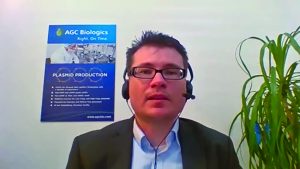 Mario Kraft, head of process development, AGC Biologics
Mario Kraft, head of process development, AGC Biologics
Kraft leads AGC’s process development team at a site in Heidelberg, Germany. He spoke about his company’s focus on plasmid DNA manufacturing and about how AGC supports its clients’ projects. The company has an established platform production process “toolbox system” for customized manufacturing of high-quality–grade plasmids for both good manufacturing practice (GMP) and non-GMP applications. With the explosion of interest in cell and gene therapies and with their improving clinical success, increased amounts of plasmid DNA are needed. The AGC toolbox can be used for meeting both low demands (<10 g needed for a niche therapy for fewer than 10,000 patients) and for supplying plasmid DNA in kilogram amounts per year.
Given the many types and variants of plasmids available with a broad range of copy numbers per cell, the company realized that a generic process is not expedient. AGC’s platform process can target plasmid DNA manufacturing at different levels. Common or special strains are needed, and different manufacturing processes also are required to meet quality specifications for final applications. The toolbox system has a platform corrector designed to address all of those points to customize a manufacturing process.
Because most clients already have established their own plasmids, AGC begins with cell-line development to screen for strains allowing high-yield production of the plasmids of interest. It uses the DH5-Alpha strain of strain of Escherichia coli, which is the most used expression system for DNA manufacturing, with a well-characterized genotype and phenotype and transparent history. If that strain shows low yield or does not fit a client’s construct, AGC then screens a strain library for an appropriate host. Although the AGC strains are proprietary, the company can test a third-party strain and has established different platform manufacturing processes suited for several plasmid types: single-copy, high-copy, and specific plasmids such as those without the CG dinucleotide (CpG). Processes performed include fermentation (batch and fed-batch), cell lysis, precipitation steps (if applicable), and purification. The company can select fermentation methods that fit a client’s needs and has established a number of processes for removing impurities and different approaches when alternatives to precipitation are needed.
Volumes of plasmid DNA larger than 1,000 L can be produced at AGC’s Copenhagen facility and at its Tokyo site (which has a 3,500-L bioreactor). Kraft showed a case study of a commercial vaccine process requiring plasmid DNA. Beginning with a master cell bank, his company prepared a preculture in shake flasks, using it to inoculate the 1,000-L culture in a multipurpose stainless-steel fermentor. Following ~15 hours of cultivation, microbes were harvested by continuous certification and processed. After cell lysis and filtration steps, the plasmid DNA was captured and purified with single-column anion-exchange chromatography. Buffered plasma DNA then was refiltered and formulated.
Such a lean process allows AGC to perform weekly manufacturing cycles for high-purity GMP-grade plasmid DNA in Heidelberg. Kraft highlighted quality attributes for technology transfer and GMP runs and outlined the purification processes used by the toolbox system. Because plasmids have special needs and the final work is subject to different client specifications, The company offers alternative purification approaches for manufacturing highly pure plasmid DNA. Kraft offered an example of how a two- or three-step downstream process can be adapted as needed.
Analytical methods demonstrate that the GMP batches produce a commercial plasma DNA with excellent yield and quality attributes. The products are approved by the US Food and Drug Administration (FDA) for DNA vaccine manufacture.
Watch the complete presentation now.
